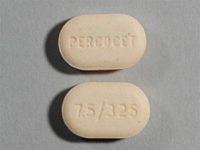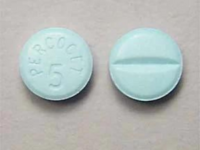-

Percocet 10-325mg
$530.00 – $1,515.00 Select options This product has multiple variants. The options may be chosen on the product page Quick View -

Percocet 7.5-500 mg
$550.00 – $1,520.00 Select options This product has multiple variants. The options may be chosen on the product page Quick View -

Percocet 7.5-325 mg
$550.00 – $1,518.00 Select options This product has multiple variants. The options may be chosen on the product page Quick View -

Percocet 5-325 mg
$548.00 – $1,519.00 Select options This product has multiple variants. The options may be chosen on the product page Quick View
Percocet is a prescription pain medication that combines oxycodone a powerful opioid analgesic and acetaminophen a non-opioid pain reliever. it is generally positive that care leads to difficult hurts such as arsenic hurt and consequently from operation hurt or progressive conditions. Oxycodone works by altering the way the brain and nervous system perceive pain while acetaminophen Improves pain relief and can reduce fever.
Due to the opioid Part Percocet is highly effective but carries significant risks including addiction tolerance and respiratory depression. long employ or abuse get run to natural addiction and prospective overdose. The acetaminophen Part if taken in excess can cause serious liver damage notably when combined with alcohol or other acetaminophen-containing products.
How Percocet Works
Percocet works through a combination of its two active ingredients: oxycodone and acetaminophen. oxycodone associate in nursing opioids alters the room the head and anxious unit comprehend and answer to hurt away back to opioid receptors. This binding blocks the transmission of pain signals and produces pain relief. tylenol amp non-opioid anodyne Improves the general pain-relieving force away reduction hurt and pyrexia. It is believed to work by inhibiting certain chemicals in the brain that are involved in the pain Answer.
Together these Parts provide effective relief for moderate to severe pain but due to oxycodone’s opioid nature, Percocet carries risks of addiction dependence and respiratory depression. it is important to employ arsenic positive to void perspective by personal effects and check the right direction
Uses of Percocet
Buy Percocet online is normally prescribed for brief-term pain management, mainly in times wherein over-the-counter ache relievers like ibuprofen or acetaminophen by are not strong enough. Common conditions for which Percocet is probably prescribed include:
Injury-related pain: It can be given for a fractured bone, severe sprain, or for any shock or trauma that occurred due to the injury.
Chronic pain conditions: Indeed, Percocet is seldom used for the patients suffering from chronic pain states like arthritis or cancer-associated pains because with time dependence on opioids is developed.
Chronic ache conditions: In some instances, however, Percocet could be given in palliative care for example in arthritis as well as in cancer however this is very limited given its ability to lead to addiction especially if used for a long time.
Dental pain: After most important dental procedures, including understanding tooth extraction, Percocet can relieve extreme pain.
Despite its effectiveness, Percocet is not intended for long-term use due to its capacity for opioid addiction, tolerance, and liver harm from the acetaminophen factor.
Percocet Side Effects
All medications have their negative impacts and so does this one except in some circumstances these effects might be unbearable. Some of them include:
Drowsiness: Extreme sleepiness or drowsiness prevents someone from driving or operating machinery. This one is due to the presence of Percocet.
Nausea and vomiting: Even Although most opioids including Percocet cause nausea and vomiting this is mainly due to the impact of opioids on the gastrointestinal system Therefore causing discomfort.
Constipation: Opiate drugs slow the movement of the digestive tract hence constipation can be controlled by the use of stool softeners or laxatives but opiate constipation Remnant a challenge among those using opiate analgesics in the long run.
Some serious side effects that require immediate medical attention include:
Respiratory depression: Opioids could slow down your breathing to a point where it becomes dangerous; this is more pronounced when the drug is ingested in very large amounts along with other CNS depressants including alcohol and benzodiazepines Ultimately outcome is oxygen starvation and loss of consciousness or even death is possible.
Severe allergic reactions: for example, a rash itching swelling severe dizziness or difficulty in breathing might indicate an acute allergic reaction of a serious nature.
Liver damage: large doses of acetaminophen may cause liver toxicity, particularly when taken alongside alcohol or otherwise in excess amounts. Some signs that there are problems with someone’s liver include yellow eyes and skin as well as dark-colored urine and also continuous feeling like throwing up.
Percocet overdose
An overdose of Percocet in us can be fatal especially due to its ability to suppress breathing. The following are signs of a possible overdose:
- Slowed or shallow breath
- Loss of consciousness
- A blue color on the lips or fingernails (hypoxia)
- Cold, clammy skin
Pinpoint pupils
When someone has taken too much substance there will be an immediate need for medical attention otherwise fatal consequences will result. Naloxone (Narcan) is an opioid antagonist that reverses all forms of opioids’ effects thereby resuming normal breathing when given immediately. To some extent, naloxone has been introduced into the market with many first responders and even people at risk for opioid overdose carrying it as a protective measure.
Alternatives to Percocet
Alternatives to buying Percocet online that healthcare providers can use in long-term pain management care with reduced risk of dependence are:
- Medications that are not opioids: It is just separate products as ibuprofen, naproxen, or acetaminophen which assist in removing slight pains alone.
- Physiotherapy: It can be through physical therapy that chronic pain is usually treated, and physiotherapy aims at improving movements with time while also reducing the severity of chronic pains experienced over time.
- Cognitive behavioral therapy (CBT): Patients suffering from persistent pains may find this psychological support helpful in the emotional and mental aspects related to them.
- Other opioids or combination remedies: Monitoring other opioids and alternative combinations of medications will help minimize the chances of addiction within their lifetime even after analgesics have been tried on them.
Conclusion
The powerful painkillers known as Percocet are used to manage moderate to severe pains during short periods. However, it can be abused, cause dependency, and have serious side effects, which necessitate the need for close supervision by medical professionals and responsible usage by patients. Understanding Percocet risks will help in using it safely and effectively while managing pain and reducing the chances of harm. It is also important that people suffering from chronic pain or those who are wary of the risks involved discuss other options for managing their pain with a doctor.
Some questions that are frequently asked:
- What is Percocet used for?
Percocet is used to manage moderate to severe pain. it combines oxycodone associated in nursing opioid anodyne with Tylenol amp non-opioid hurt fireman. This combination helps alleviate pain from conditions such as surgery injury or chronic pain. it is typically positive once different hurt medications are light.
- What are the potential side effects of Percocet?
Percocet can cause drowsiness dizziness nausea and constipation. good by personal effects admit respiratory low and liver hurt appropriate to Tylenol. Using the medication as prescribed is decisive to minimize these risks. confer amp healthcare supplier if you get difficult or relentless by personal effects
- How should Percocet be taken?
Percocet should be taken exactly as prescribed by a healthcare provider. it is typically administered by word-of-mouth inch pad cast. Do not exceed the recommended dosage or take it more frequently than directed. void devastating or breaking the tablets. For optimal safety and effectiveness follow the prescribed schedule and consult your provider for any concerns.
- Can Percocet be habit-forming?
Yes, Percocet can be habit-forming due to its oxycodone content which is an opioid. long employ or abuse get run to natural addiction margin and dependence. It is essential to use Percocet only as prescribed by a healthcare provider to minimize the risk of developing a dependence or addiction.
